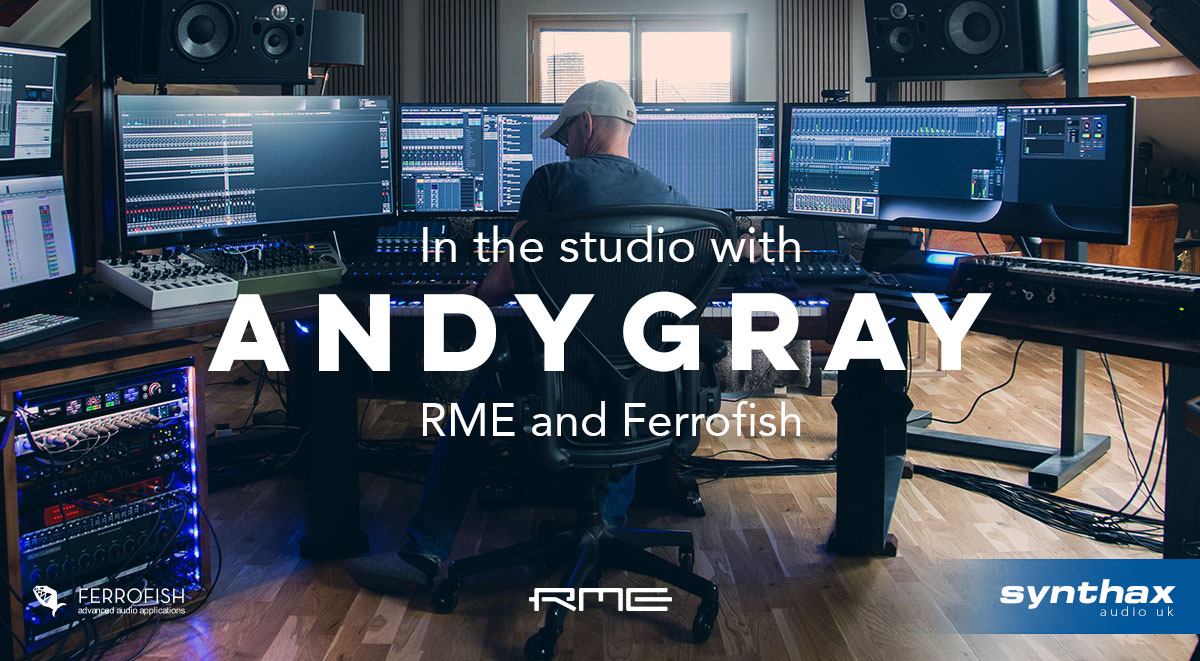
Film Composer Andy Gray discusses recording synthesizers in his Cubase and Pro Tools-based studio
“Does anyone want a mince pie?” offers Andy as we step inside his studio. “I’m trying to get rid of them if you want one?”
This is the home of Film Composer Andy Gray, who’s been recording and scoring film sound tracks from this current location – a picturesque countryside hub in Shropshire – for the past 7 years.
A Composer, Musician and Sound Designer, Andy is also known for dance music production stretching back into the 90s, as well as his work as a Producer and Programmer for a number of popular artists and bands.
Surrounded by keyboards and an eye-catching wall of modular, it’s immediately clear Andy is a true synth aficionado – no surprises then that his talents have been sought after by some of the biggest names in synth pop, new wave and dance music!
We sat down with Andy for a big ol’ chat about his career and making the switch into film composition, and why he bases his synth-heavy studio around gear from RME and Ferrofish.
In the Studio with Composer Andy Gray | RME 12Mic & Ferrofish A32pro
See more videos at Synthax TV
“I’ve enjoyed it all”
Alongside his many contributions to songs by the likes of Gary Numan and The Human League, Andy also made up one half of a formidable writing partnership with DJ Paul Oakenfold (as Perfecto), with the pair’s output including remixes of Moby’s “Natural Blues” and U2’s “Beautiful Day” – not to mention the small matter of creating the theme song for reality TV sensation Big Brother UK…
“I’ve enjoyed it all really,” Andy says reflecting on his career. “I do tend to pick the same kinds of projects, all nice people to work with. Working with Gary Numan was great, he was one of my heroes when I was a kid. Writing songs together, doing loads of remixes. We’ve become really good friends.
“I did really enjoy producing Enter Shikari. I worked with them for quite a while, we recorded Common Dreads. That was in my old studio on the Isle of Wight. Really good guys, everything recorded live. Tori Amos back in the day, moving to Cornwall to work with her, that was great fun.”
Alongside his synth and production skills, Andy is also highly regarded for his remixes – what was it like to be a Remixer in the 90s?
“Remixing for me started right at the beginning of my career,” he explains. “Back then it wasn’t as easy to create a remix. Labels would be looking for someone to kind of ‘re-work’ a song, just to help with the marketing and promotion. So there might be a version for DJs to use in clubs, there might be a Trance version or a House version or whatever. It was very lucrative at the time, there was a really big market for it before the internet, with remixes being pressed to vinyl etc.
“It’s different now, because I kind of think everyone’s got the tools to be a Remixer. So I think that kind of thing’s changed, maybe a big DJ will still get someone to help them, but these days they’ll probably just do it themselves.”
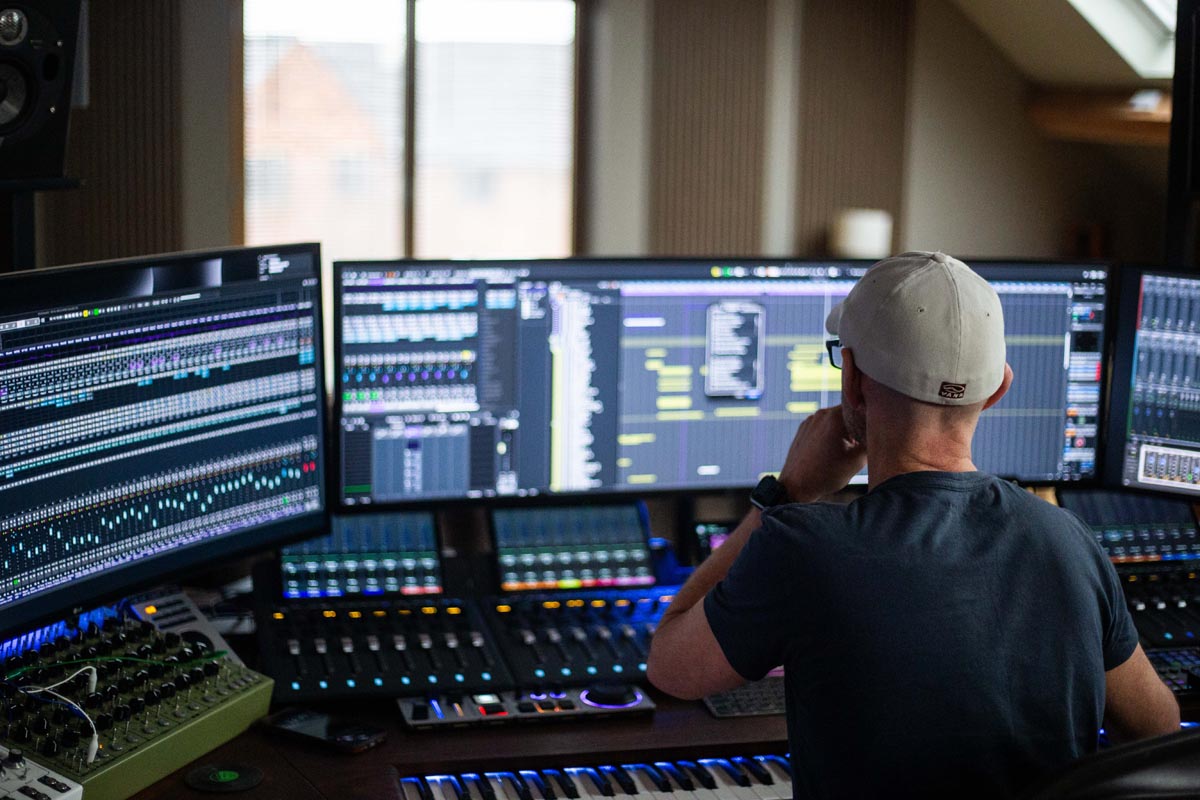
On scoring for film
Despite his background in pop and dance, these days Andy spends most of his time in the studio composing music for film.
“That really came about from working with Paul Oakenfold on the album Bunkka,” Andy says of his transition into film scoring. “We were offered some work on the film Swordfish, in about ‘98 or ‘99. And we just ended up staying in LA and doing the whole soundtrack, the electronic side at least, with Christopher Young doing the strings-side of things.
“As a kid I always wanted to do film music really, but I didn’t really know how to get into it. And it just sort of happened by accident – we went from doing Swordfish, then another film on Miramax, Steel. Then I got offered another film, TimeCop 2, just off on my own. And I kind of slowly moved away from making traditional records. My stuff already sounded quite cinematic and big, so it was just a natural progression really, although it wasn’t really planned.
“My approach is pretty much the same for each project. I’ll work off the script if I have to, say if it’s early in the production, but it’s much better when you can see the picture.
“I tend to work on the soundscapes first, to get an idea of what the mood will be. Once I get some tones and a few background ideas, then the melodies start to come. At that point you can usually start playing stuff to the director, to see if you’re on the right track.
“Sometimes they might have a temp score, i.e. music from other films as a guide, which in my opinion isn’t always that helpful. But the best way is really to start each project from scratch, experiment with some ideas, sculpt out where you think the melody is going to go. And then you can work it to the picture, fitting it to the story. You’re trying to tell a story, that’s the main thing with music for film.
“I’ve got a film that’s just come out, No Way Up,” Andy says regarding his upcoming projects. “There’s a couple of other things in the pipeline, although I don’t like to talk about them too much in case I jinx them or something, but yeah, documentaries and films coming up for the rest of this year basically.”
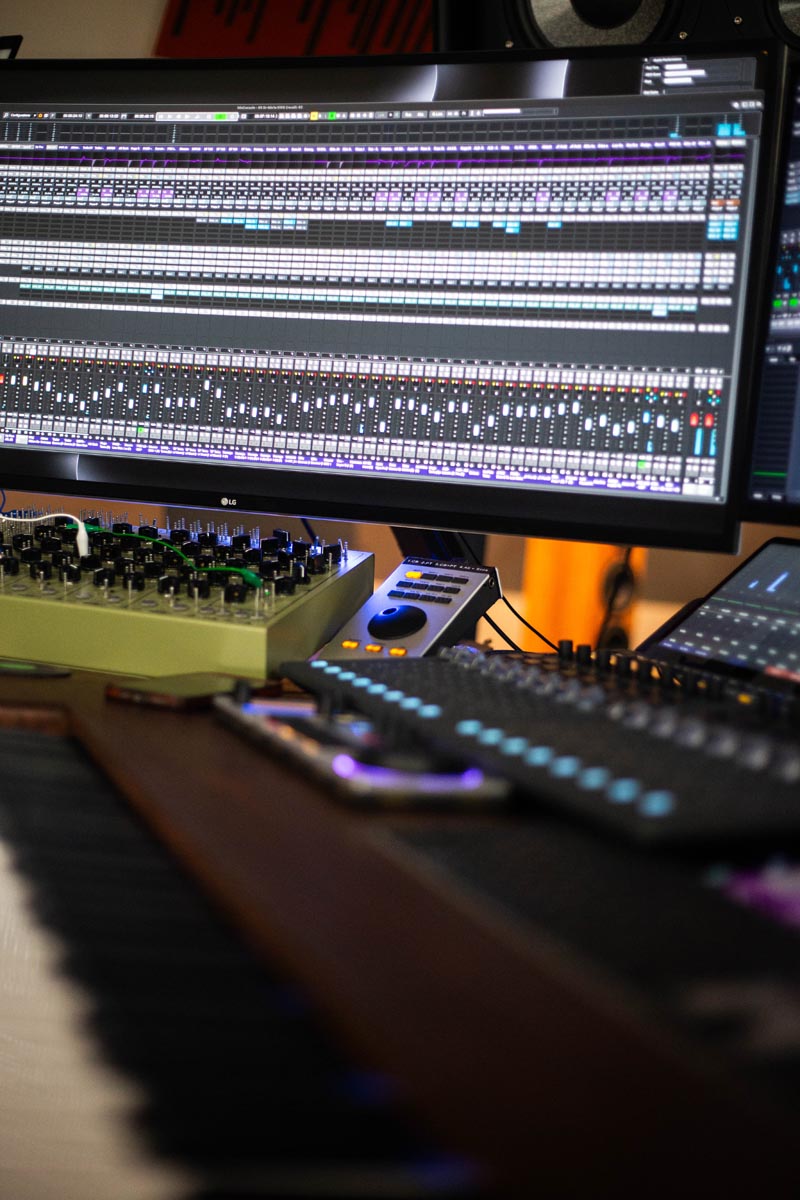 On Cubase and Pro Tools
On Cubase and Pro Tools
Andy’s studio setup consists of two systems – a main Cubase rig for composing, and a second one running Pro Tools. Why the two systems?
“There’s kind of two reasons for that,” Andy says. “One is if you’re doing a film which is reel by reel, say 5 reels or whatever, it’s quite handy as you can export a file into Pro Tools which will have all of the film in one hit. And then you’ve got that as a quick reference – you can see everything visually, almost like a patchwork quilt, whether you’re missing any cues etc.
“The second reason is because a Pro Tools file is a quite a clean and simple way to deliver the stems at the end of a project, especially since a lot of people still use Pro Tools at the dub. I don’t actually use it anymore to create or record, it’s literally just housing the stems and playing back the video, which is running off Pro Tools in sync with Cubase. Maybe I’ll change that part of the setup at some point, but at the moment it’s a pretty rock-solid way to work.
“I think if you’re not doing music to picture, then they’re all pretty equal these days,” Andy says on moving back to Cubase. “But if you’re dealing with huge amounts of data, and using tons of RAM, then a lot of them get their knickers in a twist.
“Another thing is that Cubase has a really good gate on every channel built in. And the gate is so delicate that it removes the hiss, but it doesn’t click when you play a synth. That’s perfect if you’ve got like 30 channels of analogue synths open, because it can be a bit of a ‘noise-nightmare’. The built-in effects are really good in Cubase, and they use a fraction of the memory a third-party plug-in would use, which is vital for me in how I like to work.”
Studio Tour
“One of the questions I often get asked by non-musicians is, ‘why have you got so many keyboards?’” Andy says as he gives us the guided tour. “You can only play one at a time, right?
“Well the thing about keyboards is, they’re a bit like actors. They all do the same job, but they’ve all got a different character, they all come across differently.
“Then when you sit at a certain keyboard, the way it’s set up makes you work in a certain way. Then you sit at a different keyboard, and that makes you work in a different way again.
“And I think that inspires you to make different sounds. You could make most of the sounds on one keyboard – something like the Moog One could probably do most of the sounds in this room. But it’s just not as inspiring. You’re not moving around in the studio, or working with different sets of controls.
“A wall of modular is really inspiring for making modular-types sounds,” he says motioning to the stack of knobs, patch cables and flashing lights behind him. “But trying to make something polyphonic on that? It’s really slow, you can do it but it’s slow. So that’s when you use the other stuff. It’s just having that selection, to help feed your ideas.
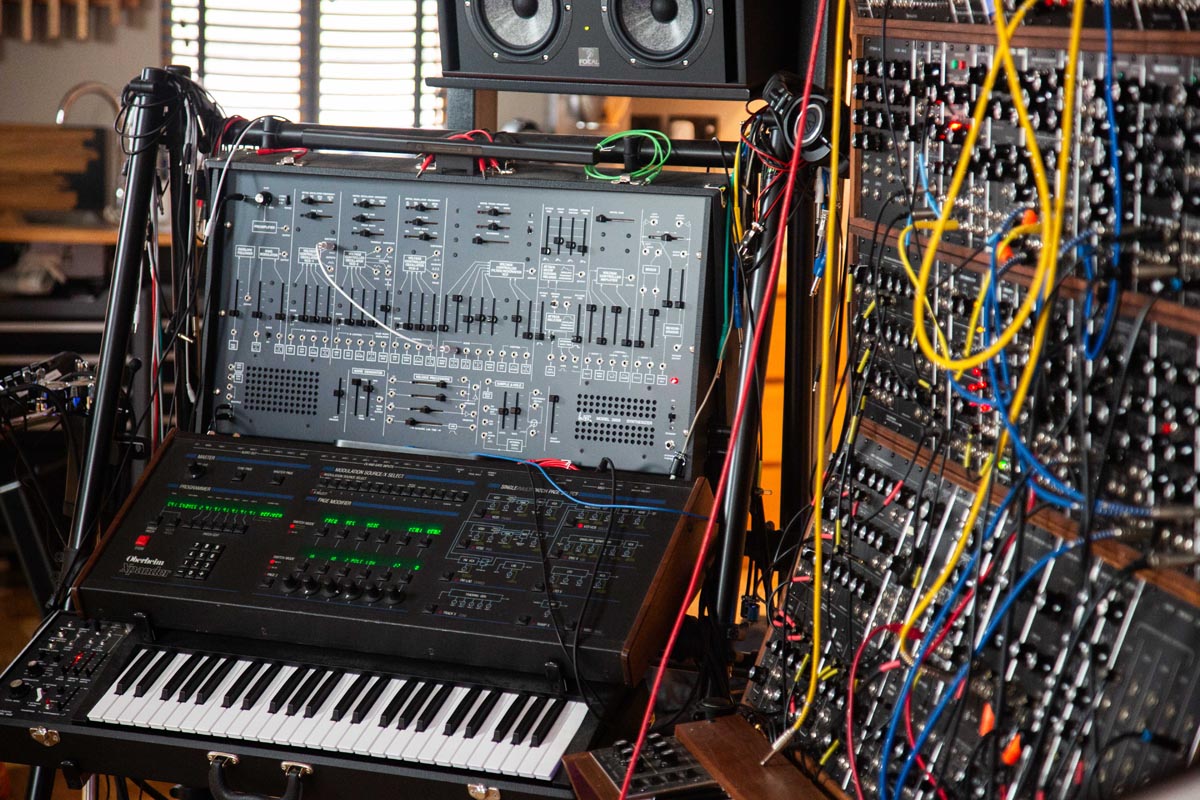
“I’ve got a lot less than I used to have, I’ve only got what I use these days. I haven’t really got a collection like I used to.”
Whilst we won’t get too into it here – see Crow Hill’s interview with Andy for the full story – part of the reason Andy’s studio is more scaled back these days, is due to losing many of his original pieces to a horrific studio fire! Huge respect to Andy for bouncing back, and remaining optimistic after such a traumatic experience.
“Yeah it was awful. Nine fire engines couldn’t put it out,” he tells us. “But from a more positive perspective, there can be something quite distracting about having loads of gear that you don’t use. I’d end up sitting in the studio thinking ‘why don’t I use that?’ So in a way it is quite nice only having the stuff I regularly use now.
“My mate BT (Trance producer) – his studio, oh my God, he’s got like every single drum machine ever made, every synthesizer, Fairlights… I mean it’s amazing his collection, but personally that would drive me nuts, having that much gear!
Synths, synths and more synths
“Something I never thought I’d own is the Korg PS 3100, that’s a great synth,” Andy says as he talks us through his beautiful selection of hardware synths. “Just really rare and weird sounding, quite thin and glassy. Jóhann Jóhannsson’s favourite synth was this.
“And then something I’ve had for years is the (Roland) System 100-M. Mine is wired quite differently – before I found everything I did on it would sound like Depeche Mode Speak and Spell! “So this time round I’ve wired it so it’s three notes polyphonic, and it actually sounds a bit more like a Jupiter-4. I really love that, again very Jóhann Jóhannsson, that kind of Icelandic vibe rather than the big American Moog sound.
“Speaking of which, then we have this monster, something else I always wanted. The bottom of the cabinet is nearly all original 60s or very early 70s Moog modular, with the two holy grail filters, the high and low pass which everyone knows. This one actually has some original reboxed Minimoog oscillators. And then I’ve added a couple of cabinets of some more modern stuff.
“What I’ve found with the old analogue gear – especially these original filters – they’re really round and woolly, they’re not exactly cutting-edge. They really sit back, they’re not like a plugin where it’s so in-your-face. And by mixing older units with some of the more modern units, I found that you get the best of both worlds, you can go from that big, round, Boards of Canada-esque detuned oscillators, to the super-sharp, modern and in-your-face sound.
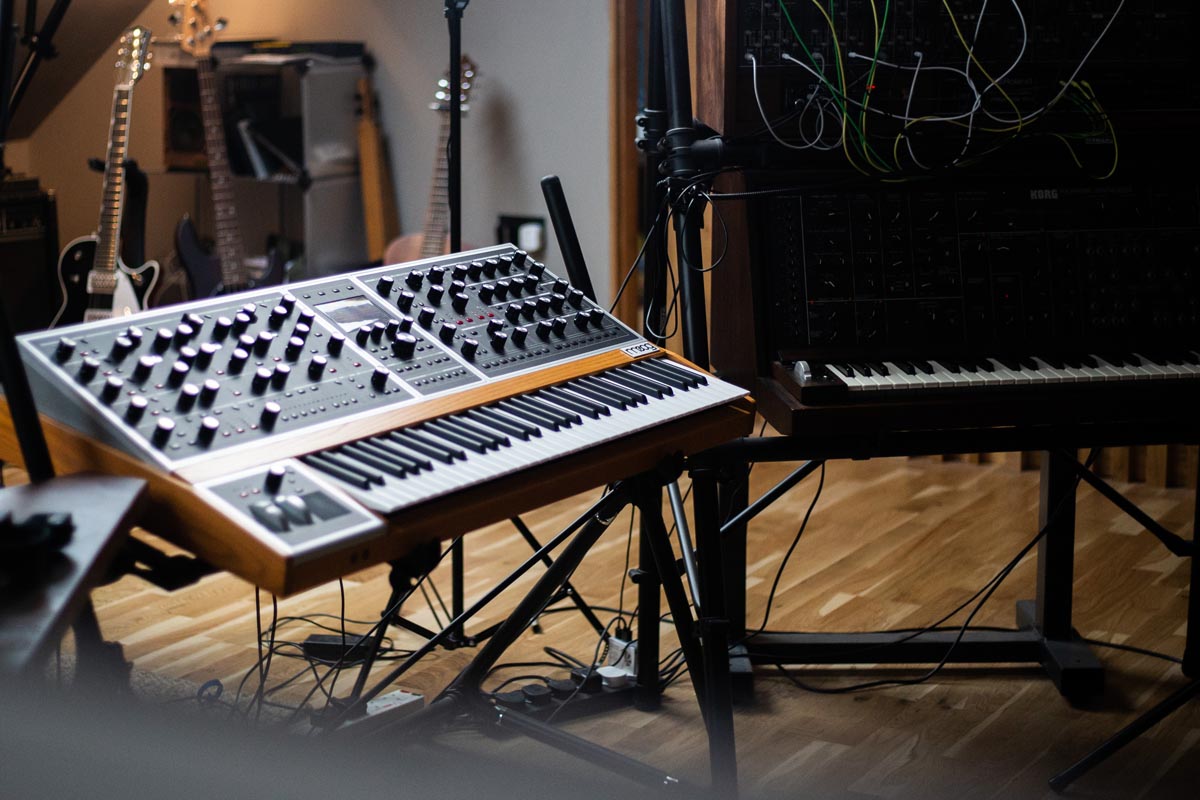
Moog One (left) and Korg PS 3100 (right)
“Then this badboy is a re-issued Arp 2600, which I mainly use for bass and drones. I’m in love with these re-issues, they sound just as good, they don’t crackle, and they don’t go out of tune.
“And then over here another re-issue, the Korg 700s, like Human League used to use. Really cool, I said I wasn’t going to buy any more synths and then this thing came along. Has a couple of tricks up its sleeve – I love the pitched noise, kind of Linkin Park style – plus your big synth bass sounds too.
“And then going over to here, this weird little box, the Lyra-8. Again, really good for your drones. Have you seen the film Arrival? Sounds like that doesn’t it! That’s a good score, Arrival.
“Then an analogue drum machine, same make as the Lyra, SOMA. Really like their stuff, really good for sound design. Very analogue, very raw. I’ll mainly just pull some noises from these and drop it straight into Cubase, chop it up and use it in a sampler. I’ve got mates who still work on drum machines, but I just cannot work loop-based – it has to be linear – I can’t work in a pattern.
“Something else I replaced straight away when I lost it, is my beloved Oberheim Expander. I know that thing inside out. I did a lot of work with Human League on their album Octopus, and I basically programmed exclusively on the Expander for that album. There’s a song on there called “Words”, and that track is just me on an Expander, no other synths on it. I love that for programming and modulation, another really cool synth.
“And then over to this thing which is just another monster, the Moog One, probably my favourite keyboard at the moment. I used to have a Memory Moog and it wasn’t really very reliable – this is similar but much more modern, it does all the analogue stuff you’d expect, wicked synth that.”
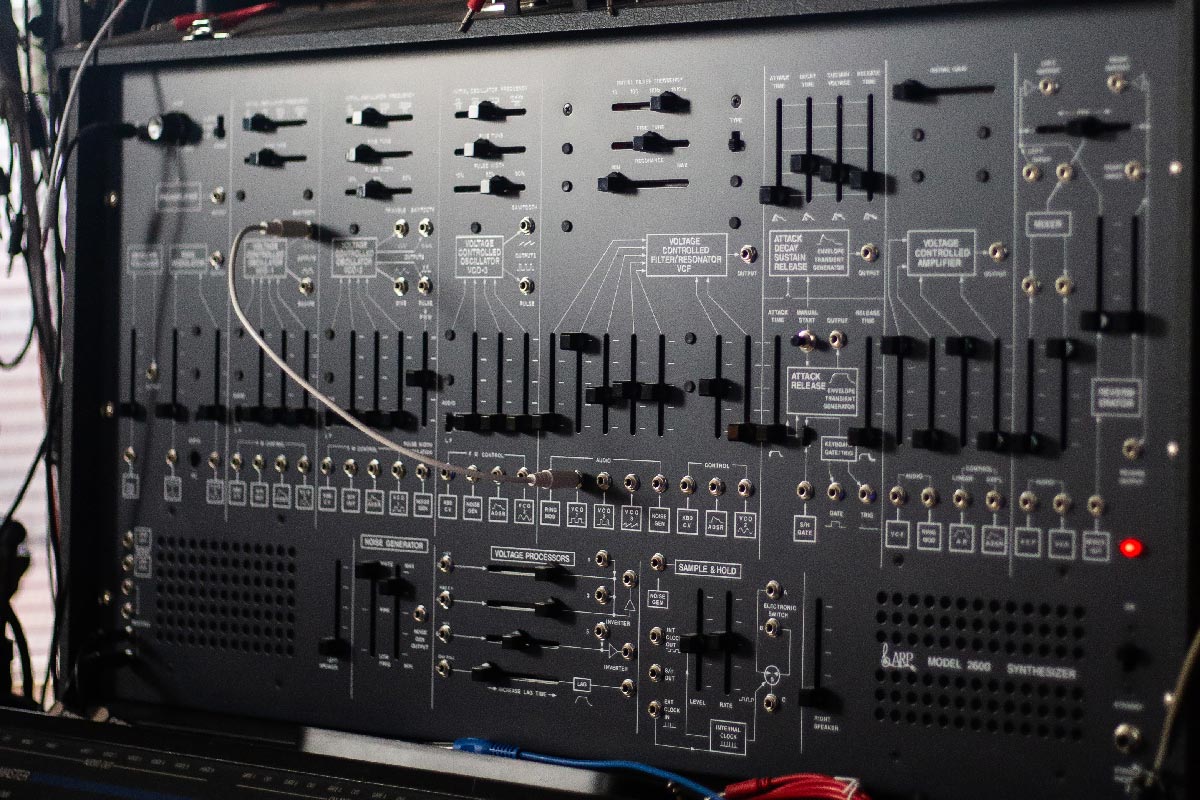
ARP 2600 FS
Guitars, Piano and Amps
“So in the guitar corner over there I finally got my arm twisted and I bought a Kemper which I’m liking so far. I’ve got my old original Fender 1957 Champ which I’ve had forever, that sounds really big miked up. And then a couple of slide guitars, mainly for doing drones and Ebow, stuff like that.
“I’ve also got a piano now. I managed to get a (Yamaha) Disklavier one where you can connect the MIDI, so I can kind of sit and work out my parts, then fire the MIDI over it to and record it playing it back. It’s really cool, I love doing that.
“Finally I’ve been collecting mics since the late 80s, and I used to also have a massive collection of mic amps. And what with re-doing the studio, I don’t know, I just found it a bit cumbersome, having loads of mic amps and all that extra gear.
So I’ve kept the vintage mics, which personally I think is more where the sound comes from. Plus I used to find that combination – using a vintage mic pre and an old mic – the noise floor just got bigger and bigger. And it was always ‘where’s the noise coming from, is it the mic? Is it the mic amp?’
“I recently switched to the 12Mic from RME for that reason – super clean mic pre, loads and loads of gain. And then you use a vintage mic connected to that, so you get your vintage sound but your signal path is pretty clean, which for me has been the best solution.”
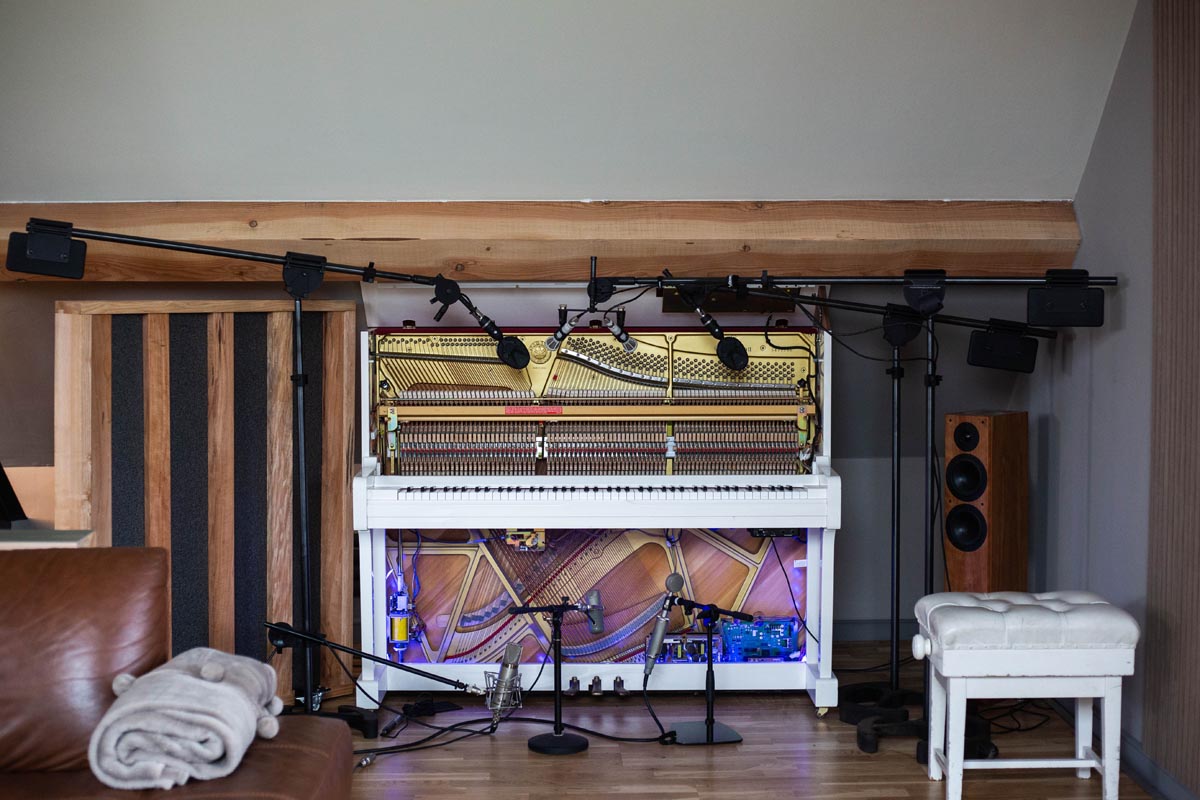
Connecting it all together
Managing everything in a modern, hybrid studio can be something of an artform itself.
With so many instruments and FX at his disposal – not to mention running two different systems – Andy needed a setup that would allow him to keep track of all his different mics and instruments easily. That way, he can focus solely on getting his ideas down.
“What I wanted was loads of I/O, just loads and loads of I/O,” Andy explains on discovering Ferrofish’s A32pro AD/DA converter. “I saw it had 32 analogue ins and outs, and then another 32 which can connect via optical.
“At first I was a bit confused as I couldn’t see any computer connections on the back, but that’s where having the RME MADIface USB comes in, which is a little interface that does USB to MADI. So the Ferrofish connects to that over this little pair of optical cables, which can connect up to 64 things in and out of the RME. That blew my mind.
“The Ferrofish then connects to the speakers for monitoring, all of my FX returns for my guitar pedals and stuff like that, and then every synthesizer is connected to it as well, plus you’ve also got two headphone connections. All of that’s permanently plugged in and set up in Cubase.
“And then the game changer was getting the RME 12Mic in there, which also goes optical to the A32pro (and then on to the RME interface), and connects every single microphone in the studio – from the guitars to tracking other people when they visit, plus the 4 or 5 mics I’ve got pretty much at any one time on the piano.
“This means that everything’s always plugged in, and it’s all labelled in TotalMix. That’s the key, everything’s connected all of the time, I don’t have to swap out mics or mess about with levels.”
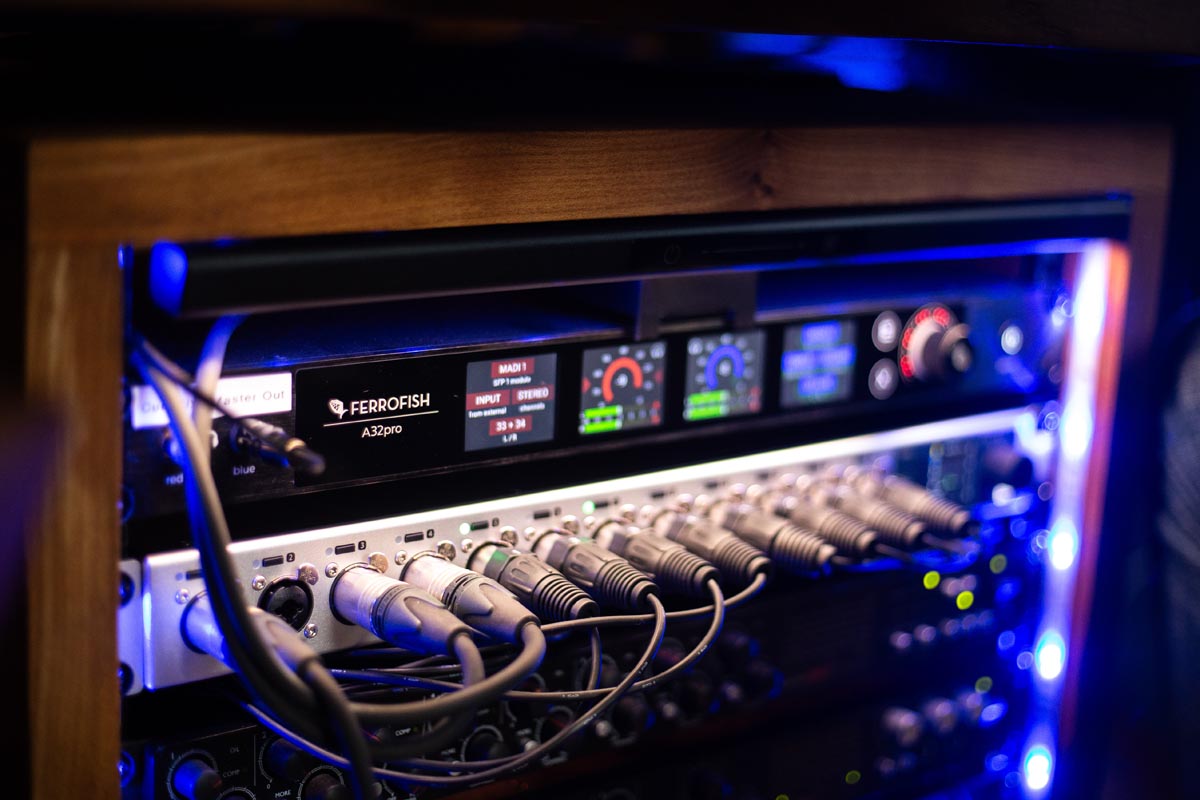
With everything set up in RME’s TotalMix mixing controller, Andy controls everything from his mouse and keyboard, as well as an iPad and RME’s ARC USB remote control.
A number of presets he’s created in TotalMix allow him to easily switch between sending different sounds to his monitors – be it Pro Tools, Cubase, his mics, synths, or a combination of the above!
“Yeah it really is a game-changer,” Andy says on TotalMix. “I don’t need a mixing desk in the studio anymore. Plus if you’re just using a DAW, whatever it may be – Cubase, Logic, Ableton etc – and you want to hear one of your synths through the speakers, then usually you’d need to enable it within the DAW. So you either have to have a track armed, or make an Aux so you can hear it. And sometimes you just want to play something, or hear something quickly and move on. With TotalMix you can just route the synths directly to the output.
“For that reason I actually have a Preset in TotalMix, with everything in the room on already. I have Preset 1 which is just Cubase. Preset 2 which just Pro Tools. Preset 3 is Pro Tools and Cubase, and Preset 4 is everything in the room – all the mics, everything on at the same time – and I can switch between them all using the ARC.
“So it’s really quick for routing something directly to the speakers. It just gives you kind of a software mixing desk, with the ARC as the master volume and a bunch of other shortcuts. It’s really simple, but really effective.”
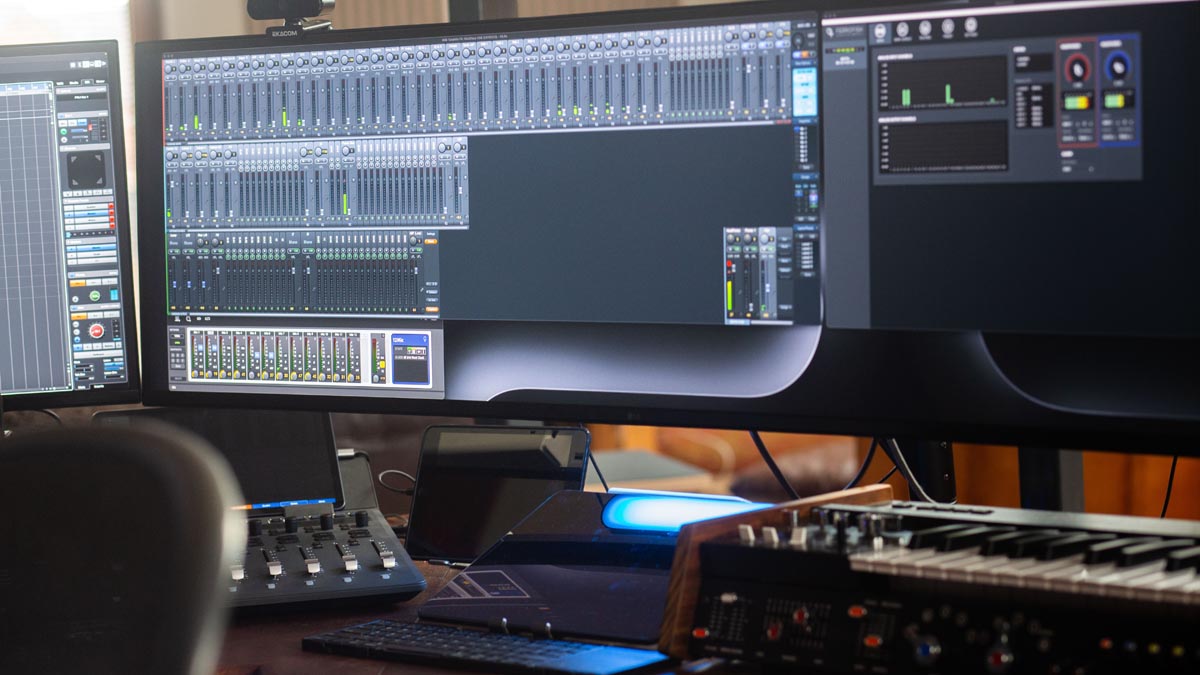 Autogain & Autoset with the RME 12Mic
Autogain & Autoset with the RME 12Mic
One extra tip Andy had for us was how he uses the RME 12Mic’s AutoSet feature. Also found on several of RME’s audio interfaces, AutoSet provides automatic overload protection when recording, allowing you to record without worrying about clipping any of your takes.
“This is really, really powerful. So how it works is, you switch it on and crank the input up, and hit a note on the piano for example. Crank it up, scary loud where it’s going to distort, play some notes, and the autogain is now set for the optimum level for that channel.
“So it’s really cool – say you’re on your own and you want to record the piano with four mics. You can just put everything on AutoSet, play the part and this will look after the input level. Really quick, really easy.”
Sounding Off…
With this being Andy’s first foray into RME devices, our final question was ‘what do you look for when choosing an audio interface?’ As it turns out, Andy’s used a number of different devices throughout his career – now, he thinks this is the best he’s ever had it.
“So originally I used Pro Tools as my main tracking rig, because that was the only thing that had audio of any big amount at the time,” he recalls. “And at that point Digidesign, who later became Avid, made their own interfaces, so I just stayed with that.
“And it was always the case for me – I do want it to sound good, I want it obviously to be the best quality it can be – but back in the day when they started to allow more third party hardware, I just found it was a really flakey connection. So I’d rather have the latest Digidesign at the time or Avid, than I would to go third party and find it wouldn’t connect properly.
“And then I moved away from Pro Tools, dipped my toe in other makes, which I stayed with for a while – it was just clunky, it wasn’t for me, it wasn’t effortless.
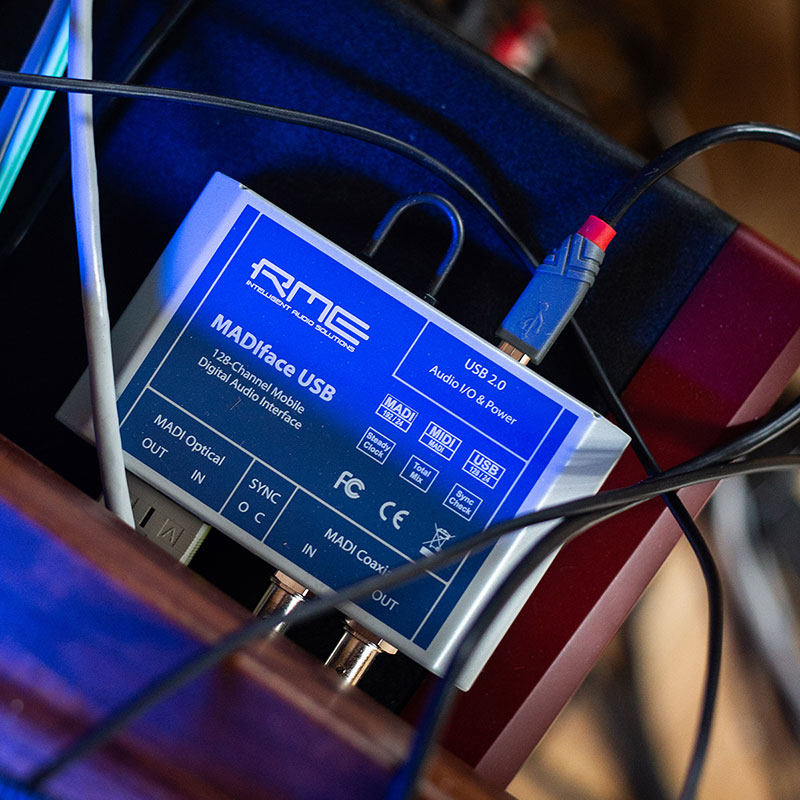 “I then came across RME on the Cubase forums, when I moved back to Cubase about a year and a half ago. It’s the first time I’ve bought RME, and it just is so easy, it’s just rock-solid. Sounds amazing, and the setup is just so easy compared to what I’ve had in the past. Certainly this combination with Cubase and an M-Series Mac laptop, I’ve never had anything so easy to use.
“I then came across RME on the Cubase forums, when I moved back to Cubase about a year and a half ago. It’s the first time I’ve bought RME, and it just is so easy, it’s just rock-solid. Sounds amazing, and the setup is just so easy compared to what I’ve had in the past. Certainly this combination with Cubase and an M-Series Mac laptop, I’ve never had anything so easy to use.
“I run my whole studio off of a laptop now, plus a couple of thunderbolt hubs. It’s super portable. I can plug the laptop in in the morning, take it out again at night, and then when I come back the next day everything’s still set up. There’s none of this driver stuff with RME, none of ‘is it going to see the driver, am I going to have to unplug it, plug it back in, reboot it?’ There’s just none of that, it hasn’t done that once.
“Jump on the train with it – I went to the dub for a film and I took my laptop with me, and there was a problem with the stem. And with a modern laptop, you can go straight into the original session, edit the MIDI or a sample, it’s really flexible. I can’t imagine not having everything on a laptop now.
“So in all a really slick system, basically in a 1U unit, then with an extra 1U for the mic pres. And yeah the sound is amazing, both the Ferrofish and the 12Mic, they sound great, I love it.”
Massive thanks to Andy Gray for giving us such an in-depth tour of his studio, and for the minced pies!
To find out more about his work, visit his website at www.andygrayproductions.com
See the full range of RME Audio Interfaces
See the full range of Ferrofish AD/DA Converters




















